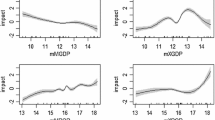Abstract
Gravity equations have been used repeatedly to predict the East-West trade potential since the opening-up of Eastern Europe in 1989. Most of the research in the field was done by means of cross-section data. While earlier studies indicated huge unexhausted bilateral trading potentials for the East and for the West, more recent studies have demonstrated that most of the East-West trading potential has already been consumed. In this paper, we provide insights into the prediction performance of cross section gravity equations (applied for level projections). We found rather large forecast interval spans around the predicted values. The intervals are of a size that makes any conclusions about absolute trade potentials questionable. Thus we think that cross-section gravity analysis does not permit any definite judgment as to whether actual East-West trade has already reached its potential level.
Similar content being viewed by others
References
Anderson, J.E. (1979) ‘A Theoretical Foundation for the Gravity Equation’, American Economic Review 69(1), 106–116.
Baldwin, R.E. (1994) Towards an Integrated Europe, Centre for Economic Policy Research (CEPR), London
Baldwin, R.E. (1997) ‘Comment on Gros and Gonciarz’, European Journal of Political Economy 13, 187–188.
Bergstrand, J.H. (1985) ‘The Gravity Equation in International Trade: Some Microeconomic Foundations and Empirical Evidence’, The Review of Economics and Statistics 67(3), 474–481.
Bergstrand, J.H. (1989) ‘The Generalized Gravity Equation, Monopolistic Competition, and the Factor-Proportions Theory in International Trade’, The Review of Economics and Statistics 71(1), 143–153.
Breuss, F. and Egger, P. (1997) Use and Misuse of Gravity Equations in European Integration Research, WIFO Working Paper (93), Austrian Institute of Economic Research, Vienna.
Brenton, P. and Di Mauro, F. (1998) ‘Is There Any Potential in Trade in Sensitive Industrial Products between the CEECs and the EU?’, The World Economy 21(3), 285–304.
Deardorff, A.V. (1995) Determinants of Bilateral Trade: Does Gravity Work in a Neoclassic World, NBER Working Paper 5377.
Evenett, S.J. and Keller, W. (1997) On Theories Explaining the Success of the Gravity Equation, unpublished paper of the University of Michigan, The Brookings Institution, the University of Wisconsin and NBER.
Fidrmuc, J. (1997) Effects of Integration of the CEEC into the EU on Austrian Trade Structure, Institute for Advanced Studies, Vienna, Interim Report.
Greene, W.H. (1997) Econometric Analysis, 3rd edn., Prentice-Hall, Upper Saddle River, NJ.
Gros, D. and Gonciarz, A. (1996) ‘A Note on the Trade Potential of Central and Eastern Europe’, European Journal of Political Economy 12, 709–721.
Hamilton, C.B. and Winters, L.A. (1992) ‘Opening up International Trade with Eastern Europe’, Economic Policy 14, 77–116.
Helpman, E. (1987) ‘Imperfect Competition and International Trade: Evidence from Fourteen Industrial Countries’, Journal of the Japanese and International Economies 1(1), 62–81.
Helpman, E. and Krugman, P.R. (1985) Market Structure and Foreign Trade. Increasing Returns, Imperfect Competition, and the International Economy, The MIT Press, Cambridge, MA/London.
Judge, G.G., Hill, R.C., Griffiths, W.E., Lütkepohl, H., and Lee, T.C. (1988) Introduction to the Theory and Practice of Econometrics, 2nd edn., Wiley, New York.
Kaldor, N. (1963) ‘Capital Accumulation and Economic Growth’, in F.A. Lutz and D.C. Hague (eds.), Proceedings of a Conference Held by the International Economics Association, Macmillan, London.
Leamer, E.E. and Levinsohn, J. (1995) ‘International Trade Theory: The Evidence’, in: G.M. Grossman and K. Rogoff (eds.), Handbook of International Economics, Vol. III, Elsevier, New York, pp. 1339–1394.
Linnemann, H. (1966) An Econometric Study of International Trade Flows, North-Holland Publishing Company, Amsterdam.
Mátyás, L. (1997) ‘Proper Econometric Specification of the Gravity Model’, The World Economy 20(3), 363–368.
Nilsson, L. (1997) The Trade Potential of Central and Eastern Europe: Revisiting the Gravity Estimates, mimeo, Stockholm.
Pindyck, R.S. and Rubinfeld, D.L. (1991) Econometric Models and Economic Forecasts, 3rd edn., McGraw-Hill, New York.
Pöyhönen, P. (1963) ‘A Tentative Model for the Volume of Trade between Countries’, Weltwirtschaftliches Archiv. 90, 93–99.
Schumacher, D. (1997). Perspektiven des Auβenhandels zwischen West-und Osteuropa: Ein disaggregierter Gravitationsansatz, Deutsches Institut für Wirtschaftsforschung, Berlin.
Tinbergen, J. (1962) Shaping the World Economy. Suggestions for an International Economic Policy, New York.
Wang, Z.K. and Winters, L.A. (1991) The Trading Potential of Eastern Europe, CEPR Discussion Paper Series, (610).
Author information
Authors and Affiliations
Rights and permissions
About this article
Cite this article
Breuss, F., Egger, P. How Reliable Are Estimations of East-West Trade Potentials Based on Cross-Section Gravity Analyses?. Empirica 26, 81–94 (1999). https://doi.org/10.1023/A:1007011329676
Issue Date:
DOI: https://doi.org/10.1023/A:1007011329676




